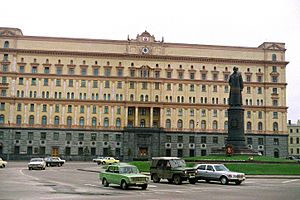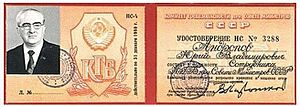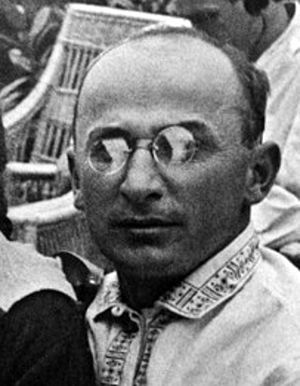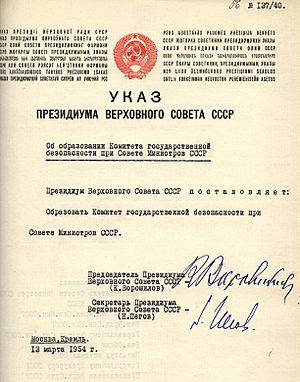KGB facts for kids
 |
|
 Lubyanka Building in 1985 |
|
| Agency overview | |
|---|---|
| Formed | 13 March 1954 |
| Type | State committee of union-republican jurisdiction |
| Jurisdiction | Central Committee & Sovnarkom (1954–90) Supreme Council & President (1990–91) |
| Headquarters | Lubyanka Square, 2, Moscow, Russian SFSR |
| Motto | Loyalty to the party – Loyalty to motherland Верность партии — Верность Родине |
| Agency executives |
|
The KGB was a very important security agency in the Soviet Union. Its full name in Russian was Komitet gosudarstvennoy bezopasnosti, which means Committee for State Security in English. It was the main agency from 1954 until the Soviet Union ended in 1991.
The KGB was like a combination of a country's internal security, intelligence, and secret police all rolled into one. It worked under the Council of Ministers. It was also a military service, following army rules just like the Soviet Army.
The KGB had many jobs. It gathered information about other countries (foreign intelligence). It also worked to stop spies from other countries (counter-intelligence). The KGB protected the borders of the Soviet Union. It also guarded important government leaders and made sure their communications were safe. A big part of its job was to stop people from speaking out against the government or trying to change the Soviet system.
After the Soviet Union broke up in 1991, the KGB was split into different agencies. Two of the main ones became the Federal Security Service and the Foreign Intelligence Service of Russia. Interestingly, Vladimir Putin, who later became the President of Russia, worked for the KGB in Leningrad.
History of the KGB
During the Cold War, the KGB worked hard to fight against ideas that were not communist. This included stopping people who spoke out against the Soviet government. The KGB watched what people thought and said, both in public and private. They also looked for any plans to start a revolution in the Soviet Bloc countries.
The KGB played a big role in stopping protests in other countries. For example, they helped to crush the Hungarian Revolution of 1956. They also acted against the "Socialism with a Human Face" movement in Czechoslovakia in 1968. Some of the KGB's secret activities are known from the Mitrokin Archive.
In 1978, the KGB was officially renamed the "KGB of the Soviet Union." Its leader became a member of the government's council. The KGB came to an end when its chief, Vladimir Kryuchkov, used the agency's power to try and overthrow Soviet President Mikhail Gorbachev in August 1991. This attempt failed.
After the failed coup, Colonel-General Kryuchkov was arrested. A new chairman, General Vadim Bakatin, was appointed. His job was to officially close down the KGB of the Soviet Union. On November 6, 1991, the KGB officially stopped existing. However, Russia's new security agency, the Federal Security Service (FSB), does many of the same things the KGB used to do.
Today, Belarus is the only country that was once part of the Soviet Union where the national security agency is still called "KGB."
How the KGB Operated
In 1983, Time magazine said the KGB was the best at gathering information in the world. It had spies working in other countries. Some spies worked openly from Soviet embassies or consulates. If they were caught, they were protected by special diplomatic rules. Other spies worked secretly, pretending to be regular people. These secret spies were often seen as more valuable because they could get closer to their targets.
The KGB used four main types of spying:
- Political spying: Gathering information about other governments.
- Economic spying: Stealing secrets about money and trade.
- Military spying: Getting information about other countries' armies and weapons.
- Disinformation: Spreading false information to trick or confuse enemies.
They also worked on stopping enemy spies and gathering scientific and technological secrets. The KGB was very good at stealing information about things like jet engines, radar, and secret codes. They were especially successful at getting atomic secrets. For example, a physicist named Klaus Fuchs helped them get information about the Manhattan Project during World War II. Another young physicist, Theodore Hall, also shared secrets from a top-secret lab in New Mexico.
Important KGB Actions

The KGB was involved in many important and often secret operations:
- The KGB worked to stop groups that were against the Soviet government. In 1940, a Spanish agent helped in the death of Leon Trotsky in Mexico City.
- The KGB often used "active measures" like spreading false information to make enemies of the Soviet Union look bad.
- For times of war, the KGB had hidden stashes of weapons in other countries for secret operations.
After World War II, the KGB secretly recruited former German intelligence officers. They used these people to try and get information from the West German intelligence service.
In the 1960s, a KGB agent named Anatoliy Golitsyn left the Soviet Union and shared secrets. Based on his information, a CIA chief named James Jesus Angleton believed there were secret spies, called "moles," working inside the CIA and FBI. Later, it was proven that he was right when spies like Aldrich Ames and Robert Hanssen were caught.
In the mid-1970s, the KGB tried to secretly buy three banks in California. They wanted to use these banks to get access to secrets about new technology companies. The CIA found out and stopped them. The KGB used a bank in London and a businessman from Singapore to try and make these purchases.
Images for kids
-
KGB special operative Igor Morozov sits on top of the BTR-60 armoured vehicle during his assignment to the Badakhshan Province, c. 1982
-
The former building of the KGB in Vilnius, Lithuania
-
Former KGB officer Sergei Ivanov meets with former CIA director Robert Gates, April 2007
-
Honored Worker of NKVD, 1940
See also
 In Spanish: KGB para niños
In Spanish: KGB para niños





















